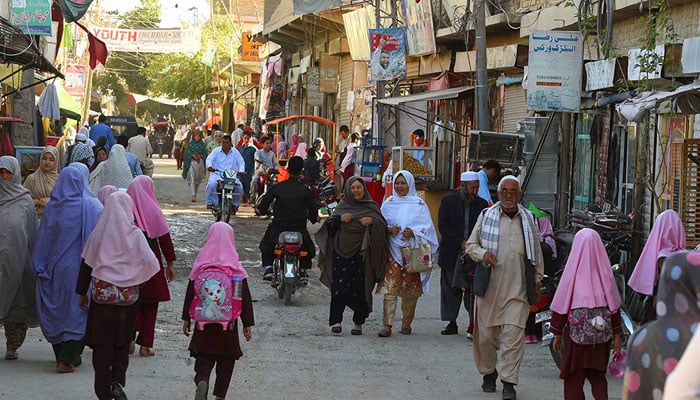Balochistan witnessed highest population growth rate, reveals census report
Pakistan’s present growth rate is highest in region.
Population to double by 2050 with same growth rate.
61% people over 10 years of age are literate in Pakistan.
ISLAMABAD: Balochistan, as per the latest census for 2023, witnessed the highest rate of population growth with a 3.2% increase, while Khyber Pakhtunkhwa (KP) recorded the lowest rate with 2.38% since the last census, The News reported on Monday.
In 2023, the country’s population grew by 2.55%, stated a detailed Census Report 2023 report by the Pakistan Bureau of Statistics (PBS).
According to the report, the average annual growth rate of Pakistan’s population was 2.45% in 1961, following which it has documented rising and declining trends over the years.
The country’s average population growth rate increased to 3.69 % in 1972 and fell to 3.06 % in 1981, before reaching 2.55% last year, it added.
Both globally and in the region, Pakistan’s present growth rate is the highest as the country ranks 191 in terms of population growth rate. Only 27 other countries, primarily in Sub-Saharan Africa, have faster growth rates than Pakistan. If this growth rate continues, country’s population will double by 2050.
As per the results of the fresh census, there are 241,499,431 people in Pakistan, while population in 1951 was 33,740,167, according to the first census. Over the next 77 years, population has expanded more than seven times, reaching 241,499,431 in 2023.
With 52.9% in 2023, Punjab has the largest proportion. Nevertheless, since 1951, the trend in the province has been declining. Although Balochistan has the lowest population percentage among the provinces, it has been steadily rising since 1951, rising from 3.5% to 6.2% in 2023.
Similarly, Islamabad, the federal capital, is also witnessing an increase in population share while bearing a small area.
Balochistan experienced the highest percentage growth, 20.75 %, while Khyber Pakhtunkhwa saw the lowest change, 15.08%, between 2017 and 2023.
With the rapid increase in population, it was observed that the country’s density was constantly increasing from 42.4 person per square kilometres in 1951 to 303.4 person per square km in 2023. Highest density (2,609.1 per square kilometer) was observed in Islamabad showing the patterns of growth of the federal capital, followed by Punjab with 622 persons per square km while the lowest is in Balochistan with 42.9 per square kilometer.
Karachi Division in Sindh emerges as the most densely populated, with a density of 5,779, followed by Islamabad with 2,609 persons per square km. Lahore Division in Punjab and Mardan Division in Khyber Pakhtunkhwa exhibit the highest population density with 1,942 and 1,461 persons per square km, respectively.
However, in Balochistan, majority divisions are less populated as compared to area. Rakhshan, Kalat, Zhob, Makran and Sibi, are thinly populated with density per km ranging from 11 to 38, emphasising the province’s vast and varied terrain. This data provides a concise overview of the distribution and density of Pakistan’s population, offering valuable insights into regional demographic patterns.
Among all the districts, the biggest is Karachi Central with the highest population density followed by Korangi. On the other hand, districts Awaran and Chagai with six persons, Washuk with nine persons, Kharan with 17 persons and Zhob with 22 persons per sq km have the lowest density in the whole country.
In Punjab, cities like Lahore, Gujranwala, Faisalabad, Sialkot and Multan exhibit high population densities at 7,339, 1,645, 1,550, 1,492, and 1,441, persons per km respectively. In contrast, districts such as Bahawalpur, Rajanpur, Khushab, Bhakkar, and Chakwal show lower population densities at 173, 193, 231, 240, and 266 persons per sq km respectively.
The federal capital, Islamabad, stands out with a substantially high population density of 2,609 persons per sq km, reflecting the rapidly increasing population. This district-wise analysis provides a comprehensive overview of the demographic patterns in Punjab and Islamabad, essential for informed policymaking and development planning.
In Sindh, all districts of Karachi being the economic hub are densely populated. Karachi Central has the highest density with 55,396 persons per sq km, followed by Korangi, Karachi East, Karachi South and Karachi West, with population densities of 28,972, 28,214, 19,096, and 7,242 persons per sq km respectively.
However, in contrast some of the districts of interior Sindh such as Tharparkar, Sujawal, Jamshoro, Thatta and Khairpur are sparsely populated with 91, 96, 100, 126, and 163 persons per sq km respectively, reflecting a more dispersed demographic pattern in these districts. The country’s 61% of over 10 years of age are literate in Pakistan.

